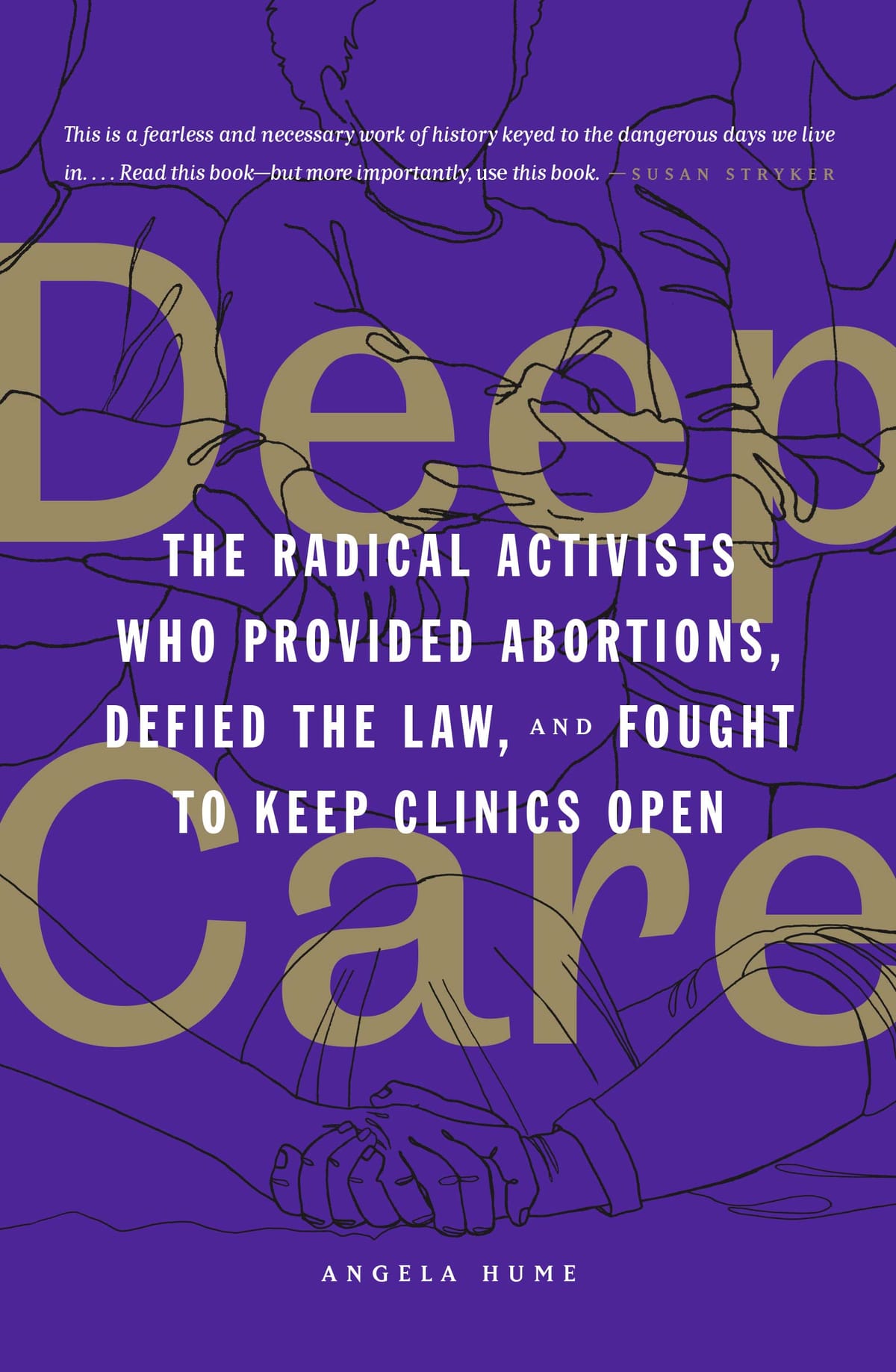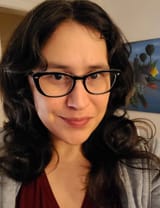Use All The Tools of Your Being: A History Lesson
"We're not visualizing an embryo. We’re just thinking, I’m pregnant, I don’t want to be," said Carol Downer.


The following is an excerpt from Deep Care: The Radical Activists Who Provided Abortions, Defied the Law, and Fought to Keep Clinics Open by Angela Hume, published by AK Press.
The story of an invention
A mason jar, a one-way valve, and some flexible tubing. A cannula and a syringe. Let’s go back to April 1971—I want to tell you the story of an invention.
Lorraine Rothman thumbed through her husband’s science lab mail-order catalog. White and middle class with four kids, Lorraine sometimes also worked as an assistant to her husband, a biologist. She lived in suburban Orange County and was thirty-nine years old.
Through her local National Organization for Women (NOW) chapter, Lorraine started doing abortion activism. Under the Therapeutic Abortion Act, signed into law under Governor Ronald Reagan in 1967, abortion was legal in California but only when a pregnant person’s life or mental health was determined, by multiple doctors, to be at risk. That is to say, abortion was legal but still mostly inaccessible; thus, abortion law repeal was a critical issue. Lorraine and some other feminists demanded that all laws that restricted and controlled women be repealed.
Try to hold a picture of Lorraine leafing through her husband’s catalog in your mind while I take you around a bit more. At that time, the abortion reform and repeal movements were in high gear. Thirty-some miles north of Lorraine, in Los Angeles, a white working-class activist named Carol Downer was also passionately engaged with the abortion struggle. Thirty-eight years old, Carol had six children. She had had two abortions, one illegal and one “therapeutic.” Since 1969 she’d been a member of the abortion committee for her NOW chapter, in which she and the others would visit local women’s groups to talk about abortion. Lana Clarke Phelan of the Society for Humane Abortion was the committee head—and Carol’s mentor.
In addition to working with NOW, Carol in 1969 started organizing with a small group. Julie Barton, Elaine Heiman, Cheryl Libbey, Mary Petrinovich, and Carol were the “original five” who decided to take abortion into their own hands, she told me when I visited her in Los Angeles in 2019.
In 1969, the original five became acquainted with an abortion provider named Harvey Karman and his colleague, a doctor named John Gwynn, who together ran an illegal clinic on Santa Monica Boulevard. As Carol put it to me, she and the others started “hanging around” the clinic and observing Harvey and John at work. Harvey was not a licensed doctor (his degrees were in psychology and theater), but he had been performing abortions in the region for a decade and a half and was well known as a provider and an outspoken activist. By 1969 he had been arrested twice and imprisoned for two and a half years after being “convicted of abortion.”
By that time, Harvey had developed and begun to introduce a thin, flexible plastic cannula, a game changer for early-term suction abortions. A cannula is like a straw. When connected to a syringe, it makes simple suction procedures possible. Suction abortion with a plastic cannula was a less-invasive alternative to dilation and curettage (D&C) for early procedures, which required scraping the inside of the uterus with a metal instrument.
When the original five realized Harvey’s suction technique was simple enough for other laypeople to perform, they began to study it. In this realization, Carol was inspired by her mentor Lana along with Pat Maginnis and Rowena Gurner, who through their work with the Society for Humane Abortion in the 1960s and early 1970s ran an extensive abortion referral service, in addition to teaching classes about how to self-abort. Only a few months later, at a Los Angeles conference on abortion for physicians, presented by a company that sold aspirating machines, the original five marched onto the stage unannounced. With the others flanking her, Cheryl announced, “Doctors, we’re going to do it ourselves. Women are going to take this back.”
Around the same time, Carol organized a rally to support Harvey and abortion rights: five hundred people showed up at Hancock Park. On a battery-powered record player that she had brought from home, Carol put on “Land of Hope and Glory” and announced that they would be establishing the “Fellowship of Felons.” She invited anyone who’d had an abortion to come forward if they wanted to. People did. One woman later told Carol that when she stood up, it was the first time she’d come out to her mother as having had an abortion.
Carol told me about a moment that contributed to her understanding that ordinary people could learn how to do abortions. In 1970, she had accompanied a friend and the friend’s daughter to Harvey’s clinic so that the daughter could have an IUD inserted. From behind her thick oval frames, Carol observed the daughter’s cervix as she lay on the exam table with a speculum in place. Her cervix, she thought, was entirely accessible. It was right there.
Then, in April 1971, Carol and some others from the original five called a meeting. Held in the front office of a house in Venice, the home of Everywoman’s Bookstore and Everywoman’s Newsletter, the meeting was intended to be an informational event about starting an underground service. Thirty-some people attended, including Carol’s precocious teenage daughter Laura Brown.
Among them, also, was Lorraine.
Attendees crowded in shoulder-to-shoulder; some sat cross-legged on the office floor. One of the organizers had brought a manual-suction device Harvey had built—a cannula attached to a plastic syringe. Carol held up the device and tried to explain it. It made people visibly uncomfortable, “green in the gills,” she told me. To ease their worry, she decided to show the group just how accessible, in fact, the cervix is.
From on top of the office desk, she leaned back, pulled up her skirt, and spread (or “pried,” as she remembered it) her legs apart. She angled the gooseneck desk lamp so that it illuminated her vulva and then inserted a plastic speculum into herself. Carol had taught herself how to perform a cervical self-exam with a mirror, speculum, and flashlight in the preceding months. She wanted to show them all how close the cervix is to the opening of the vagina.
People stood up, gathered around her, and leaned in, taking turns peering inside of Carol’s body. Mary volunteered to do a cervical self-exam next. By the end of the meeting, six or so of the attendees had gotten on top of the desk. The room was electric. “How many children have you had?” people asked. “You look totally different!”
Lorraine was inspired by Carol’s demonstration. “The fact that this particular area of the body that has been inaccessible to us is now visualized. . . . It was so revolutionary,” Lorraine later said. After the meeting, she couldn’t stop thinking about Harvey’s device. One problem with it was that it didn’t have a mechanism to stop air from being pumped back into the uterus, which can cause an air embolism and be deadly. Another problem was that if the syringe were to fill up, the cannula would have to be taken out (so the syringe could be emptied) and reinserted.
A gust of wind swept through the open window and caught the corners of pages as Lorraine scanned the industrial supply mail-order catalog. There, she thought. A one-way valve. The valve would prevent air from being pumped back through the tubing into the uterus.
After ordering the valve and gathering some equipment from hardware and grocery stores, an aquarium shop, and the lab where her husband worked, Lorraine set to work reimagining the device. She laid out her supplies:
Sharp knife or razor
Cutting board
Four-millimeter cannula
Five-millimeter cannula
Six-millimeter cannula
Aquarium (Tygon) tubing (one fifteen-inch length and one thirty-inch length)
One-way valve
60cc syringe
Two-hole #13 rubber stopper (to seal the jar)
Half-pint mason jar
Toothpicks
First, Lorraine cut one-inch pieces off the five-millimeter cannula, creating two small adapter tubes that would be used to bridge together tubing of different widths. She attached one of these five-millimeter adapters to the valve post and connected the fifteen-inch length of aquarium tubing to it, then fit the valve to the 60cc syringe. When pulled, the syringe’s plunger would create suction. Then, with the help of a toothpick, she pushed the six-millimeter cannula through one of the two holes of the rubber stopper until there was only an inch protruding out of the top of the stopper. Lorraine allowed a half inch of the cannula to stick out from the bottom of the stopper and cut off the excess. She fed the remainder of the six-millimeter cannula through the other hole of the rubber stopper, repeating the process to create two six-millimeter adapter tubes running through the stopper.
Next, she connected the free end of the fifteen-inch length of tubing to one of the six-millimeter adapters protruding from the top of the stopper. She attached the thirty-inch length of tubing to the stopper’s other adapter tube protruding from the top, then fitted the stopper tightly into the mason jar, sealing it like a lid. The mason jar, supplied from Lorraine’s kitchen, would serve as the receptacle for collecting the blood and tissue from the uterus.
Lorraine fit the remaining five-millimeter adapter to the free end of the longer, thirty-inch length of tubing. If the procedure was done using a small four-millimeter cannula inserted through the cervix, this five-millimeter adapter would ensure a tight fit, but if a larger five- or six-millimeter cannula were used instead, the adapter would not be needed. Finally, she tested the fit by inserting a thin four-millimeter cannula a half inch into the adapter. During an actual procedure, this last cannula to be fit in would need to be kept sterile so that its free end could be inserted directly through the os and into the uterus.
Pulling on the syringe attached to the set of tubing on one side of the stopper would create a vacuum inside the jar. The vacuum would then produce the suction needed to draw blood and tissue up through the set of tubing on the other side of the stopper, into the jar. The one-way safety valve would ensure that no air could travel the reverse direction back into the uterus.
As she stood back to review her work, Lorraine’s stomach did a flip. She couldn’t help but smile.
Not long after, Lorraine would name her device the “Del-Em,” a jab at a doctor who once called it a “dirty little machine.” She also patented it. Lorraine and the others wanted to keep the device out of the wrong hands.
The simple answer to our need
Lorraine, Carol, and some other West Coast Sisters—a group that came together in 1971 to develop the “self-help clinic concept,” as they started calling it—began practicing using the Del-Em on both people who were and were not pregnant. The West Coast Sisters also began meeting regularly for “clinics,” where they practiced cervical self-exam. By examining the consistency of their cervical mucus (slippery and stretchy meant fertile) and noting changes in the color and texture of their cervixes, they tracked their cycles. STI’s, contraception, and abortion were all topics for inquiry and exploration. They met at the bookstore, in people’s houses, and eventually at the Los Angeles Women’s Center on South Crenshaw Boulevard in South Los Angeles, out of which they began to run an abortion referral service, connecting women with providers.
The West Coast Sisters transformed a couple of back rooms in the women’s center into the Los Angeles Feminist Women’s Health Center (LAFWHC). The space was small and seemed always to be at least semi-crowded. There was a well-worn couch and chairs arranged in a circle, newspaper clippings and posters for political demos tacked up on the walls, and supplies for performing self-exam—speculums, mirrors, gloves, lube—cluttering tables.
What happened next is fascinating: the West Coast Sisters decided to bring the Del-Em to the NOW conference taking place in Santa Monica that August 1971. But they didn’t call the device and procedure “suction abortion”; instead, they called it “menstrual extraction,” a concept that they had “evolved” in the months since the Del-Em’s invention. They distributed flyers inviting people to come to their hotel room to watch demonstrations, and dozens of people showed up for their “ME marathon.”
Starting from the time of the Del-Em’s public debut at the conference, the West Coast Sisters told a story in which “menstrual extraction is not a euphemism for abortion.” They emphasized, “When the Self-Help Clinic means abortion we refer to it as abortion. . . . Our advanced groups must not be misrepresented if they are going to continue to work effectively for all women.”
Lorraine later wrote, “We saw the possibilities of using the non-traumatic method for reasons other than early abortion. We had practiced on one another during our menstrual periods and we learned that introducing a four-millimeter cannula into the os of the cervix caused very little pain so that it was unnecessary to use any anesthetic. We learned that simple sterile techniques were sufficient, since there was no breaking of the skin or scraping of tissue. We also learned that it was possible to extract the major portion, or all, of the typical menstrual period.” They would write that, with a Del-Em, “Women could free themselves of heavy, crampy periods, or avoid having a period if it would interfere with travel, vacation or perhaps an athletic event, and could extract the contents of the uterus if there was the possibility of unwanted pregnancy.”
The West Coast Sisters knew they couldn’t openly practice abortions, so they went to lengths to distinguish their practice from the one performed by physicians. Menstrual extraction was a form of “research into women’s health needs.” It was a “home-care procedure” in which “the woman having her flow extracted controls all aspects of [it],” as opposed to a clinical procedure administered by a doctor. It was practiced not by individuals but by groups of people working together to build skills.
The objective of menstrual extraction was not necessarily pregnancy termination, because, according to the story the West Coast Sisters told, it was usually performed on or around the first day of a person’s expected period, before the person could know if they were pregnant. Or before a person would think or choose to use the term “pregnant” to describe themselves. Of course, if a person didn’t want to be, or didn’t want to become more, pregnant, an extraction would ensure that they weren’t, or wouldn’t. And if a person suspected they had been pregnant, the group would check the contents of the jar for chorionic villi—yellowish tissue with branchlike structures, or products of conception—to confirm that the pregnancy had been removed. But even so, for early self-helpers (and for some later self-helpers, too), an abortion resulting from an extraction was not so much an aim as a corollary to an action that people who could become pregnant could take to assert their right to bleed.
The story that menstrual extraction was “not a euphemism for abortion,” at least in the beginning, was both a practical front and a challenge to mainstream definitions of pregnancy. Moreover, underground self-help understood itself as a form of collective knowledge production and shared care. The West Coast Sisters emphasized that “sisterhood is safety.” As much as it was about learning a technical procedure, menstrual extraction was about “sisters learning from sisters and helping other sisters to fully realize their control over their own bodies.” West Coast Sister Debi Law said at one point, “Menstrual extraction is much more than the technique. It is also the setting, the close community of women, the information sharing, the simple answer to our need.”
Murphy observes, “ME [menstrual extraction] was out of time in relation to abortion. Abortion law did not apply to the first moments of a predicted missed period. . . . ME materialized its object as ‘menses’ indifferent to the presence or absence of a zygote.” Through its proclaimed “indifference” to whether the recipient of an extraction was pregnant according to the medical establishment, menstrual extraction, or underground abortion self-help, as I’ve argued, created an autonomous zone outside of the clinic, the law, the commodity (as Murphy points out, too), and mainstream medical definitions of the female reproductive system and cycle.
Practically speaking, however, underground self-helpers across the decades were not indifferent to the presence or absence of an embryo. Determining whether a potential recipient of an extraction could be or was pregnant affected how a group would measure risks and go forward (or not) with a procedure. In fact, determining how pregnant a person was using only eyes and hands was a skill that self-helpers worked to develop.
For practical reasons, the presence or absence of an embryo mattered. For political reasons, it did not. “Why did you decide to call the Del-Em procedure ‘menstrual extraction’ and not ‘suction abortion’?” I asked Carol over the phone in May 2022. A draft of the Dobbs decision had just been leaked. Carol’s mind was going a million miles per hour. Here’s what she told me:
To practice the procedure, we had to start using ourselves, our own uteruses. [The concept of menstrual extraction] arose out of our gaining that familiarity. Lorraine pointed out that the way we think is: When are we going to get our period? And if we don’t get our period, we begin to think that maybe we’re pregnant. And we keep wanting to have our period. If we can take some herb and bring it on or something, we think, well, good, I brought on my period. It’s a seamless thing. We’re not visualizing an embryo. We’re just thinking, I’m pregnant, I don’t want to be, how can I not be pregnant.
It’s not that people are ignorant. It’s just that when it’s your body, you’re not caught up in these categories. It’s the patriarchy that makes the categories. Lorraine was looking at it from our point of view. It was from that point that we proceeded.
The self-helpers’ initial project of learning how to perform at-home abortions became also about learning how to extract their periods because extracting their periods was what they had to do to become proficient in a procedure that would help them help each other not be pregnant. To subscribe to a categorical distinction between abortion and menstrual extraction was to submit to a patriarchal understanding of the body, the female cycle, pregnancy, and fertility control. For the West Coast Sisters, to receive a menstrual extraction was simply to say: It’s my body. It’s normal for my body to bleed. And I assert my right to bleed.
1 FFWHCs, New View, 123.
2 Rebecca Chalker and Carol Downer, A Woman’s Book of Choices: Abortion, Menstrual Extraction, RU-486 (New York: Four Walls Eight Windows, 1992), 114.
3 See Ziegler, Dollars for Life, 6.
4 As Pat Maginnis emphasized, the Therapeutic Abortion Act created obstacles by setting up hospital committees made up of multiple physicians who were tasked with determining whether a woman was eligible for a therapeutic abortion. Pat Maginnis, “Elective Abortion—A Woman’s Right,” c. 1966–1967, MC 289, box 1, folder 62, RSHA, Schlesinger.
5 West Coast Sisters, “Self-Help Clinic,” 1971, SSC-MS-00394, box 5A, Topical Collection on Women’s Health (hereafter TCWH), Sophia Smith Collection, Smith College Special Collections, Northampton, MA (hereafter SSC).
Lorraine and other self-helpers’ call for the repeal of all abortion laws dovetailed with that of Pat Maginnis, Rowena Gurner, and Lana Phelan’s at that point the well-established Society for Humane Abortion. See Baehr, “The Army of Three: Making Abortion Public,” Abortion without Apology, 7–20.
6 Chalker and Downer, Woman’s Book of Choices, 114; Brown, “Blood Rumors,” 155.
7 Murphy, Seizing the Means, 155–56; Elaine Woo, “Creator of Device for Safer Abortions,” Los Angeles Times, May 18, 2008, https://www.latimes.com/archives/la-xpm-2008-may-18-me-karman18-story.html; People v. Karman, 5583, California Court of Appeal, Second Dist., Div. Three (November 13, 1956).
8 Dudley-Shotwell, Revolutionizing Women’s Healthcare, 14–15.
9 Chalker and Downer, Woman’s Book of Choices, 115.
10 Lorraine Rothman, “Menstrual Extraction,” Quest IV, no. 3 (Summer 1978), reprinted in Women’s Health Movement Papers (May 1981): 11, Archives of Sexuality and Gender (hereafter ASG), San Francisco Public Library, San Francisco, CA (hereafter SFPL).
11 Baehr, “Army of Three,” Abortion without Apology, 7–20.
12 Chalker and Downer, Woman’s Book of Choices, 114.
13 My telling of the first self-help meeting is largely based on Carol’s account to me.
14 Murphy, Seizing the Means, 46; Chalker and Downer, Woman’s Book of Choices, 114–15; Brown, “Blood Rumors,” 15.
15 Dudley-Shotwell, Revolutionizing Women’s Health Care, 17.
16 Murphy, Seizing the Means, 47.
17 Chalker and Downer, Woman’s Book of Choices, 115–16.
18 Chalker and Downer, Woman’s Book of Choices, 115–16. The following steps are based on Lorraine Rothman, “How to Put a Del-Em Menstrual Extraction Kit Together,” n.d., RL.00427, box 62, folder 1, Feminist Women’s Health Center Records (hereafter FWHCR), David M. Rubenstein Rare Book and Manuscript Library, Duke University, Durham, NC (hereafter Rubenstein). I first encountered this document in *Izabel’s personal collection.
19 Suzann Gage, When Birth Control Fails: How to Abort Ourselves Safely (Hollywood: Speculum Press, 1979), 17–19.
20 Chalker and Downer, Woman’s Book of Choices, 116.
21 Dudley-Shotwell, Revolutionizing Women’s Health Care, 20.
22 View the patent at https://image-ppubs.uspto.gov/dirsearch-public/print/downloadPdf/3828781.
23 West Coast Sisters, “Self-Help Clinic Part II,” 1971, SSC-MS-00394, box 5A, TCWH, SSC.
24 Feminist Women’s Health Centers, “The Four Levels of Self-Help Clinic,” n.d., H MS c261, box 67, “Menstruation: Menstrual Extraction” folder, Boston Women’s Health Book Collective Subject Files (hereafter BWHBCSF), Harvard Medical Library, Francis A. Countway Library of Medicine, Boston, MA (hereafter HML).
25 FFWHCs, New View, 18; Chalker and Downer, Woman’s Book of Choices, 118.
26 FFWHCs, New View, 18.
27 Feminist Women’s Health Centers self-help slideshow, n.d., Linci Comy personal collection.
28 West Coast Sisters, “Self-Help Clinic Part II.”
29 Chalker and Downer, Woman’s Book of Choices, 117.
30 West Coast Sisters, “Self-Help Clinic Part II.”
31 Rothman, “Menstrual Extraction.”
32 FFWHCs, New View, 121.
33 West Coast Sisters, “Self-Help Clinic Part II.”
34 FFWHCs, New View, 121.
35 Rothman, “Menstrual Extraction.”
36 Rothman, “Menstrual Extraction”; FFWHCs, New View, 127.
37 West Coast Sisters, “Self-Help Clinic Part II.”
38 Debi Law presentation, Proceedings of the Menstrual Extraction Conference (San Francisco: Oakland Feminist Women’s Health Center, 1974), 34, *Max’s personal collection.
39 Murphy, Seizing the Means, 160.
40 On May 2, 2022, Politico published a leaked draft of the Dobbs v. Jackson Women’s Health Organization Supreme Court opinion, which stated that “Roe and Casey must be overruled.” Such a leak was unprecedented in Supreme Court history. The leak triggered outrage and protests around the country. Josh Gerstein and Alexander Ward, “Supreme Court Has Voted to Overturn Abortion Rights, Draft Opinion Shows,” Politico, May 2, 2022, https://www.politico.com/news/2022/05/02/supreme-court-abortion-draft-opinion-00029473.




